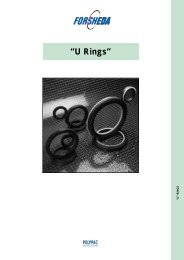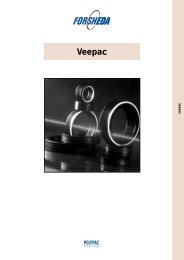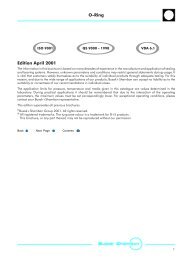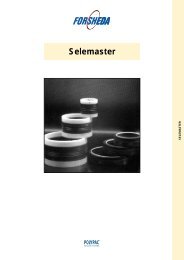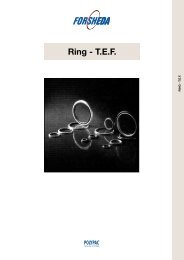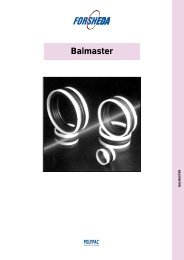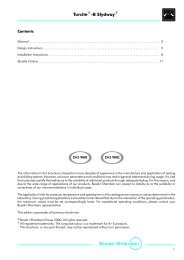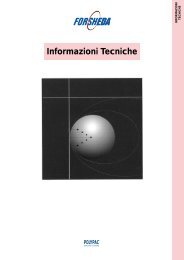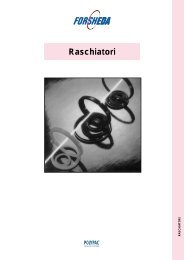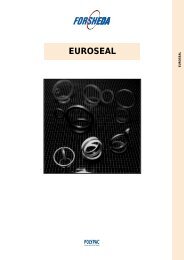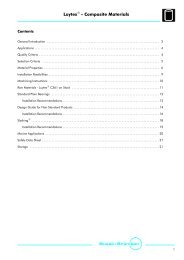Rotary Seals - Dilanda.it
Rotary Seals - Dilanda.it
Rotary Seals - Dilanda.it
You also want an ePaper? Increase the reach of your titles
YUMPU automatically turns print PDFs into web optimized ePapers that Google loves.
<strong>Rotary</strong> Seal<br />
Shaft run out and eccentric<strong>it</strong>y should as far as possible be<br />
avoided as these parameters may cause leakage depending<br />
on the capabil<strong>it</strong>y of the sealing lip to follow the shaft<br />
movements. Lim<strong>it</strong>s can be found in the various chapters.<br />
They may vary for the different seal materials.<br />
For example, leakage classes are defined for oil seals in DIN<br />
3761 Part II (Motor vehicles). Today “zero leakage“ is<br />
demanded in practice for motor vehicle applications. Zero<br />
leakage means that under various cond<strong>it</strong>ions the fluid<br />
being sealed must be absolutely separated from the<br />
environment.<br />
n Environment<br />
Leakage control<br />
When defining leakage control one must differentiate<br />
between static sealing (sealing of two surfaces w<strong>it</strong>hout<br />
motion relative to one another) and dynamic sealing<br />
(relative motion between the two surfaces).<br />
W<strong>it</strong>h a moving seal surface, a fluid film separates the<br />
sliding surfaces from one another; a dynamic seal gap<br />
forms. The leakage path is not fully closed off as w<strong>it</strong>h static<br />
sealing, so small quant<strong>it</strong>ies may escape. <strong>Seals</strong> in which a<br />
dynamic seal gap forms between the seal body and a<br />
rotating shaft cannot be tight in the physical sense.<br />
Absolute tightness in the physical sense cannot be achieved<br />
w<strong>it</strong>h a seal gap alone when sealing moving parts.<br />
For many technical applications, however, <strong>it</strong> is qu<strong>it</strong>e<br />
adequate if the “leakage“ is reduced to such an extent<br />
that there are no negative consequences for the<br />
environment or the operation of the assembly. This is<br />
called technical tightness.<br />
Environmentally-friendly hydraulic fluids (bio oils)<br />
When machines or process equipment is hydraulically<br />
operated, escaping hydraulic oil can pollute surface<br />
waters and the ground. One way of minimising the<br />
danger posed by unwanted leakage, is the use of<br />
biologically degradable, non toxic oils. In many countries,<br />
there are already statutory regulations and catalogues of<br />
requirements for dealing w<strong>it</strong>h materials that endanger<br />
water. Hydraulic and transmission fluids that protect the<br />
environment are already specified in some cases. Figure 1<br />
shows the types of biodegradable fluids.<br />
Environmentally-friendly fluids have application in all<br />
systems, which operate for example in mobile and<br />
agricultural machinery and in the water and forestry<br />
industries. In stationary systems, they are employed in<br />
plants where water is endangered, such as locks, water<br />
turbines and for foodstuffs and pharmaceutical products.<br />
An important cr<strong>it</strong>erion for biologically rapidly degradable<br />
fluids is their compatibil<strong>it</strong>y w<strong>it</strong>h seals. In Table II the<br />
resistance of elastomeric materials are given to “bio-oils“.<br />
They are, however, provided w<strong>it</strong>h a number of comments.<br />
Technical tightness must be specified by the user or<br />
manufacturer of an assembly, i.e. in some circumstances<br />
maximum perm<strong>it</strong>ted leakage rates must be defined.<br />
Biodegradable Hydraulic Fluids<br />
Vegetable<br />
Oils<br />
Synthetic Fluids<br />
Triglyceride<br />
HETG<br />
Synthetic<br />
Ester Oil<br />
Polyglycol<br />
HEPG<br />
Rapeseed<br />
Oil<br />
Polyalphaolefins<br />
PEG<br />
PPG<br />
Figure 1<br />
Biodegradable hydraulic fluids<br />
Latest information available at www.busakshamban.com<br />
Ed<strong>it</strong>ion April 2006<br />
11



